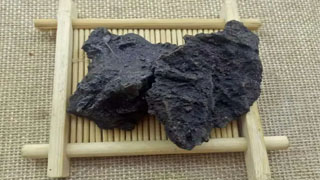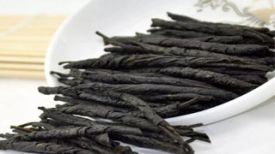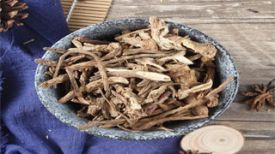
Harvesting and processing: Cut the bark of lacquer trees, collect the resin that flows out on its own as raw lacquer, and the clumps that solidify after drying are called dry lacquer. But most products collect dry residue adhered to the walls or bottoms of paint jars, which is then processed into satin and used as medicine.
Medicinal parts: Dried product of processed lacquer tree resin
Origin: All regions except Heilongjiang, Jilin, Inner Mongolia, and Xinjiang
Science: Lacqueriaceae
Original plant: Lacquer tree
Plant condition: deciduous trees
Up to 20m. The bark is gray white, rough, with irregular longitudinal cracks, and the small branches are thick and robust, covered with brown soft hairs; Winter buds grow on the top of branches, large and prominent, covered with brownish yellow hairs.
Odd feather compound leaves spiral, alternate, 22-75cm long; The petiole is 7-14cm long, covered with soft hairs, swollen near the base, semi-circular, and flat on top; There are 4-6 pairs of small leaves, with petioles measuring 4-7mm in length, ovate, ovoid or oblong in shape, 6-13cm in length and 3-6cm in width. The tips are gradually or sharply pointed, and the base is skewed, round or broadly wedge-shaped. The entire margin is hairless or slightly hairy on the midrib, with fine hairs initially present below. In old age, it is densely covered with light brown soft hairs along the veins; 10-15 pairs of veins, slightly convex on both sides, with a membrane to thin paper texture.
The inflorescence is 15-30cm long and covered with grayish yellow soft hairs; Heteroecious or dioecious plants with yellow green flowers; Male flower sepal 5, ovate, approximately 0.8mm in length; Petals 5, oblong in shape, flowers rolled outward; Stamen 5, approximately 2.5mm long, attached to the edge of the flower disk, filaments linear, anthers oblong; The female flowers are smaller than the stamens, with a spherical ovary, 1 chamber, a diameter of about 1.5mm, and 3 styles.
The fruit sequence is slightly drooping, the drupe is kidney shaped or oval shaped, not skewed, slightly flattened, 5-6mm long and 7-8mm wide, the outer skin is yellow, hairless, glossy, and does not crack when mature, the middle skin is misshapen, with resin stripes, the nucleus is brown, and is the same shape as the fruit, about 3mm long and 5mm wide, hard. The flowering period is from May to June, and the fruiting period is from July to October.
Characteristics of dried lacquer medicinal herbs: This product is irregular block shaped, black brown or brown brown in color, with a rough surface, honeycomb like small holes or granular shape, and has a glossy appearance. Hard in texture, not easily broken, uneven in cross-section, with a special odor. Burning in the presence of fire, black smoke, and stronger paint odor.
High quality products are best if they are solid, black in color, hard, and have a strong paint odor.
Dry paint properties:
This high-quality dry lacquer has a pungent and warm taste. It is used to heal wounds, nourish the middle, renew muscles and bones, fill the marrow and brain, soothe the five hidden organs, slow down the five periods, and relieve the six urgent periods. It can also alleviate wind, cold, dampness, and rheumatism. After long-term use, it is light and durable. Raw lacquer can eliminate pests
It has a pungent taste and enters the Jueyin liver meridian. Specializing in the meridians, good at breaking down the syndrome.
The "Golden Chamber" Dahuang Zu Chong Wan (formulated in Dahuang) is used to treat deficiency, fatigue, and fullness of the abdomen, as well as dry blood in the body. It is used to dissolve hardness and break dry blood.
Dry lacquer has a strong and pungent nature, good at breaking blood stasis, and its power is very agile. And it is suitable for killing various insects, suppressing liver qi, and transforming blood stasis into worms. Fry until dry, grind carefully.
【 Origin 】 Produced in Sichuan, Anhui and other places in China, it is the fat of lacquer tree, which is naturally dried and used as medicine. [Taste] Spicy, warm in nature, non-toxic.
【 Indications 】 Dry lacquer can break blood stasis, promote muscle and bone development, treat wind cold dampness, stagnation, hernia, heartache, and amenorrhea.
【 Exclusive 】 Dry lacquer therapy for cough, relieving blood stasis, swelling, and lower back pain, female hernia, benefiting the small intestine, and removing warts and worms.
[Zhen Quan] Kill three insects, the main woman's meridians are blocked.
The Great Ming Dynasty dealt with the transmission of corpses and labor, and eliminated wind.
[Element] Remove the accumulated stagnation of deep and firm knots over time, and break through the stagnant blood that has accumulated over time.
Nourish muscles and bones, dispel wind and dampness.
[Dosage] Regular five to two yuan.
[Taboo] Fear Sichuan pepper, perilla, chicken eggs, and crabs. Avoid oil and fat, as it can greatly damage the blood and qi of the body. Do not use it if there is stomach deficiency, large sores, or no blood stasis. For those who have been poisoned, Chinese fir, perilla, lacquer, and grass can be used to relieve it. For ordinary people who fear lacquer, chewing Sichuan pepper and applying it to their mouth and nose can be avoided. "
[Preparation] Take dry lacquer and let it burn dry over high heat; Or knock it into small pieces, stir fry in a pot until it is burnt and black with smoke, take it out, and let it cool.
[Taste] Spicy, warm; Toxic.
Return to the liver and spleen meridians.
【 Functions and Indications 】 Breaking blood stasis, eliminating accumulation, and killing insects. Used for women with amenorrhea, blood stasis, and abdominal pain caused by insect accumulation.
【 Usage and Dosage 】 2.4-4.5g.
【 Attention 】 Pregnant women and those with no blood stasis should use it with caution.
【 Storage 】 Sealed storage, fireproof.


